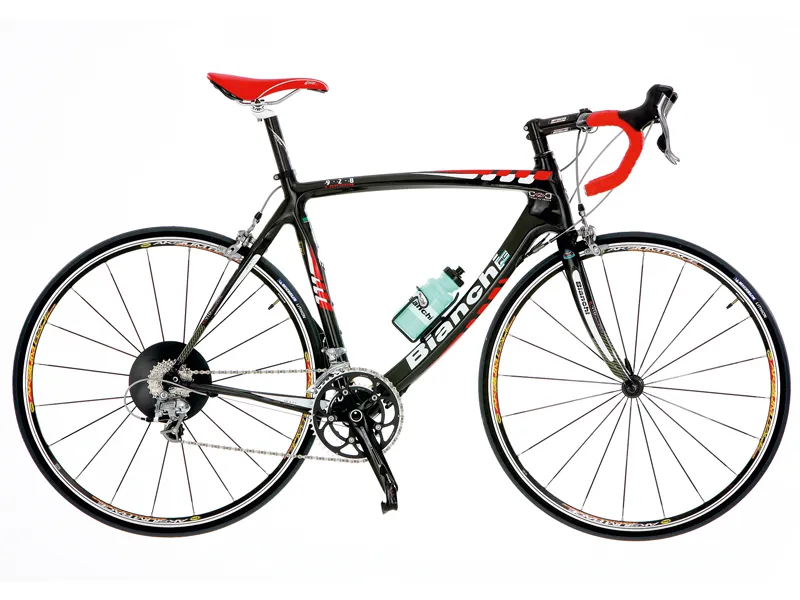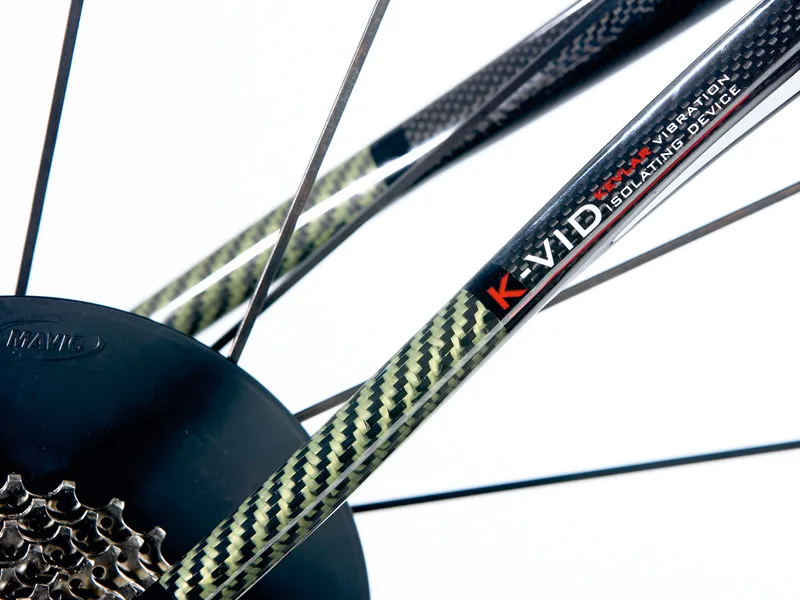The £1300 price point is one of the most popular among bike buyers and consequently the manufacturers all want a big slice of the action. Bianchi is no exception and makes a play for your unlucky ton with the 928 C2C 105.
Frame: the Lurpak effect
Bianchi's carbon monocoque frame is supremely comfortable, dissipating road vibration almost completely to produce a butter-smooth ride. With its curved down-tube, another slight arc in the top-tube and barely a round profile in sight, it's one that passers-by like to stop and look when you break for a mid-ride cuppa.
Bianchi makes much of the 928's high head-tube and the relaxed ride position it has produced, but the front end is actually the lower than many of its competitors. In fact, none of the proportions or angles are significantly different from a traditional road bike's geometry, so you get a fairly low, aero-ride position, but the frame still manages to feel like a sportive bike that's been built for comfort - which is a good trick, if you can pull it off.
How come? Bianchi puts a Kevlar insert, which it calls a K-VID (Kevlar Vibration Isolating Device), into the wishbone seatstays and the carbon fork legs; whether it's this that's responsible or not is impossible to say, but the resulting ride is certainly exceptionally buzz-free.
Handling: comfort and speed
As we said right at the top, despite quite a low-slung riding position the Bianchi is an extremely comfortable machine, damping out road vibration and offering plenty of vertical compliance for a really forgiving ride. But that comfort doesn't come at the expense of speed...
Although it can't quite stay with lighter bikes on the climbs, the Bianchi is no slouch and it'll make up time going down the other side, as the lack of buzz allows you to focus on the job in hand rather than the rattling of your fillings.
The longer your ride, the better the Bianchi is. Many efficient bikes can leave you battered and torn after a couple of hours in the saddle but we stayed feeling fresh and ready for more on the 928 for much longer than usual - to the point that we were starting to wonder if we just weren't trying hard enough. And when you're not worrying about aches and pains that come part and parcel, you can concentrate on putting the hammer down or enjoying the view - whichever takes your fancy.
Wheels: light 'n' classy
The Bianchi rolls along on Mavic's entry-level Aksium Race wheels - but entry-level is relative; these are far better than opening gambits from most other brands. The milled rims provide a uniform braking surface and are fairly low weight while the well constructed hubs are fitted up with smooth cartridge bearings although, if we're being picky, we'd prefer better sealing. You get an impressive 20-bladed, straight-pull spokes radially laced on each wheel and the overall look is pretty darn classy. >The Aksiums have a tight feel and rapidly spin up to speed. We got a small amount of flex when really blowing out on the climbs, but rarely enough to cause brake rub or sap the fuel tanks. > >Equipment: nuthin' fancy
In keeping with its long distance comfort ethos, the Bianchi sports a compact FSA Gossamer crankset. Matched up to a 12-25T cassette, the small 34T chainring will get most riders up most hills even at the end of a long, lumpy sportive while, at the other extreme, we only found ourselves running out of gears in the 50T big ring on the steepest, straightest descents.
The Bianchi's components are up to scratch and generally of the level you'd expect at this price. After a bit of tinkering here and there, and cursing, the 105 rear mech shifted as well as the front one, while the brake callipers might be a little chunkier and heftier than Shimano's more expensive options but their power doesn't lag too far behind.
The anatomic drops and flattened tops of FSA's Wing Pro bar offer several good hand holds, although we're less keen on its carbon-wrapped OS 190 stem - what's wrong with being out and proud as alloy? Bianchi's own carbon seatpost is the real deal but Fizik's Aliante saddle was way too squishy for our taste - after 45 minutes we brought on a sub.
Verdict
We're not saying that alloy frames with carbon seatstays have had their day but, as we've seen, the bar has been raised at the £1300 price point and any bike of this genre needs to come up with something special to compete. The Bianchi is a remarkable all-day mile muncher with a frame that really is so comfortable you start to doubt the effort you're putting in. The spec is good too, but if you have the money and inclination to upgrade as the parts wear out you'll end up with a fabulous bike.


